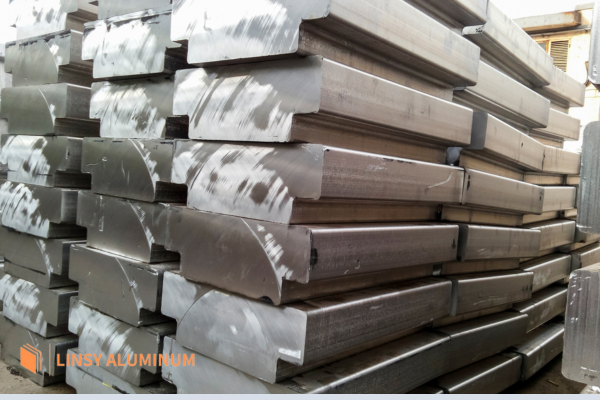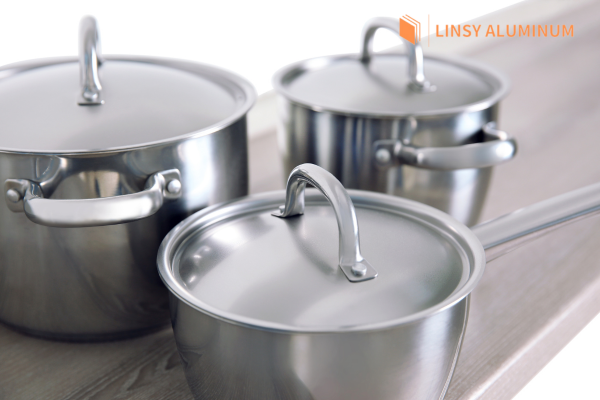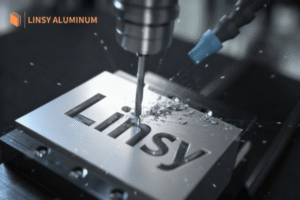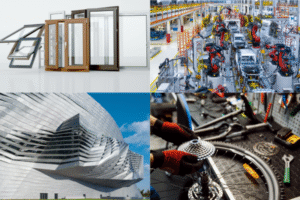Key Highlights
- 1050 aluminum alloy is a commercially pure aluminum grade known for its excellent corrosion resistance, high ductility, and formability.
- The alloy is highly workable and easily shaped into intricate designs, making it suitable for various applications.
- It is commonly used in sheet metal work, but its low strength limits its use in structural applications.
- 1050 aluminum is also recognized for its high thermal conductivity, making it an efficient material for heat exchangers and similar applications.
- With its bright, reflective surface, it’s used for decorative purposes and products like lamp reflectors.
- It is easily welded using various techniques, although its softness may pose challenges when machining.

Introduction
In metals, aluminum alloy is a testament to versatile utility and strength. Among its many variants, 1050 aluminum alloy stands out. Renowned for its exceptional corrosion resistance, this alloy is a workhorse in industries requiring durability and resilience. From architectural flashings that protect buildings to intricate components within chemical processing plants, 1050 aluminum alloy has become a reliable and adaptable material.
Introduction to 1050 Aluminum Alloy
1050 aluminum alloy, a popular grade known for its excellent corrosion resistance and high ductility, is widely used in various industries. It features a reflective finish and moderate strength, making it suitable for applications like lamp reflectors, food industry containers, and architectural flashings. With its high thermal conductivity and general sheet metal work capabilities, 1050 alloy is a preferred choice. Understanding its mechanical properties, chemical composition, and different tempers is essential for utilizing this versatile aluminium alloy effectively.
What is 1050 Aluminum?
1050 aluminum is a widely used type of aluminum known for being easy to shape. It contains at least 99.5% aluminum, along with small amounts of iron and silicon. This simple mixture retains the great qualities of pure aluminum like good resistance to rust and high ability to carry heat. This alloy goes by different names such as AA1050A, S1B, and A91050, and is used in many fields from wrapping products to gadgets. Its flexibility allows manufacturers to mold it into detailed shapes using common metalworking methods easily. However, because 1050 aluminum is very soft, it can be tricky to work with and may not be suitable for tasks needing lots of strength. Still, its special mix of traits makes it very important in various industries.

Key characteristics and benefits of 1050 Aluminum
1050 Aluminum is celebrated for its remarkable combination of characteristics that make it indispensable across diverse industrial sectors. Its high ductility allows easy shaping and forming, while its excellent corrosion resistance ensures a longer lifespan, even in harsh environments.
Excellent thermal conductivity further enhances its appeal, making it suitable for applications requiring efficient heat dissipation. This unique blend of properties makes it an ideal material for a wide range of products and components.
Here’s a closer look at its key benefits:
- Superb formability: 1050 Aluminum readily adapts to various forming processes, including deep drawing and spinning, allowing for intricate designs.
- Outstanding corrosion resistance: Its inherent resistance to corrosion makes it suitable for outdoor applications and exposure to moisture.
- High thermal conductivity: Efficiently transfers heat, making it ideal for heat sinks, heat exchangers, and similar applications.
Chemical Compositions of 1050 Aluminum
|
Element |
Percentage (%) |
|---|---|
|
Aluminum (Al) |
99.5 (minimum) |
|
Iron (Fe) |
0.4 (max) |
|
Silicon (Si) |
0.25 (max) |
|
Copper (Cu) |
0.05 (max) |
|
Manganese (Mn) |
0.05 (max) |
|
Magnesium (Mg) |
0.05 (max) |
|
Zinc (Zn) |
0.05 (max) |
|
Others |
0.03 (max each) |
The chemical makeup of 1050 Aluminum Alloy is super simple—it’s mostly aluminum (at least 99.5%), which keeps it light, easy to shape, and good at fighting rust. The other bits, like iron (up to 0.4%) and silicon (up to 0.25%), are tiny add-ons that make it a little tougher and easier to work with, but they don’t change much. There’s hardly any copper, manganese, magnesium, or zinc (all 0.05% or less)—just enough to say they’re there, but not enough to matter. This purity is why 1050 is soft, bends well, and carries electricity great. It’s like plain vanilla—basic but perfect for pans or wires!
Applications of 1050 Aluminum Alloy

1050 Aluminum Alloy’s remarkable properties lend themselves to various applications. Its high resistance to corrosion, excellent formability, and thermal conductivity make it an ideal choice for use in food industry containers where hygiene and preservation are paramount. Because of its non-toxic nature, it is also widely used in chemical process plant equipment handling sensitive materials.
Beyond its industrial uses, 1050 Aluminum Alloy is a mainstay in general sheet metal work owing to its ease of fabrication. Its versatility knows no bounds, from architectural flashings protecting buildings from the elements to reflective panels in lighting fixtures.
1050 Aluminum vs. Other Aluminum Alloys
While 1050 Aluminum Alloy is celebrated for its specific properties, it is essential to understand how it compares to other aluminum alloys. Each alloy in the aluminum family offers a unique combination of characteristics, making them suitable for particular applications.
Comparing 1050 with other alloys helps determine its suitability for specific project requirements, ensuring optimal material selection for demanding applications. Let’s explore how 1050 compares to its counterparts.
1050 vs. 1060 vs. 1100 vs. 3003 Aluminum Alloy

|
Feature |
1050 Aluminum Alloy |
1060 Aluminum Alloy |
1100 Aluminum Alloy |
3003 Aluminum Alloy |
|---|---|---|---|---|
|
Main Makeup |
99.5% Aluminum |
99.6% Aluminum |
99% Aluminum + tiny copper |
Al + 1% Manganese |
|
Strength |
~75–110 MPa (soft) |
~70–105 MPa (soft) |
~90–120 MPa (soft) |
~110–145 MPa (soft) |
|
Corrosion Resistance |
Excellent |
Excellent |
Excellent |
Very Good |
|
Electrical Conductivity |
61–63% IACS |
61–62% IACS |
59–62% IACS |
40–50% IACS |
|
Workability |
Really easy to shape |
Really easy to shape |
Really easy to shape |
Easy, a bit stiffer |
|
Typical Use |
Pans, reflectors |
Wires, light parts |
Foil, wires |
Cookware, tanks |
These four alloys—1050, 1060, 1100, and 3003—are light and useful, but each does something different.
1050 and 1060 Aluminum are almost pure aluminum (99.5% and 99.6%), so they’re soft (70–110 MPa) and good at carrying electricity (61–63% IACS)—perfect for pans or wires. They bend easily and don’t rust. 1100 Aluminum has a little copper, making it stronger (90–120 MPa) and great for foil or wires, with good electrical power, too (59–62% IACS). 3003 has manganese, so it’s tougher (110–145 MPa) but not as bendy or good with electricity (40–50% IACS)—ideal for cookware or tanks. All resist rust, but 3003 Aluminum is less flexible for more strength. Choose 1050 or 1060 for soft electrical jobs, 1100 for more strength, and 3003 for sturdy stuff!
Conclusion
In conclusion, understanding the properties and applications of 1050 Aluminium Alloy is crucial for various industries. Its unique characteristics make it a versatile choice for different purposes. From its chemical compositions to comparing it with other aluminum alloys, knowing the specifics can guide your material selection process. If you are considering using 1050 Aluminum Alloy for your projects, thoroughly explore its welding and machining capabilities. For commercial inquiries or quotes related to 1050 Aluminium Alloy, please contact us for more information.
Why Choose Linsy Aluminum
As one of the leading aluminum brands and a top supplier in China, Linsy Aluminum emphasizes quality and reliability in all its products. Our advanced aluminum factory in China manufactures high-performance aluminum alloys that satisfy the toughest industry requirements. Dedicated to excellence, we provide precision, durability, and tailored options to accommodate your specific project needs, establishing us as a trusted partner for businesses globally searching for exceptional aluminum solutions. GET A QUOTE
Frequently Asked Questions
Can 1050 Aluminium Be Welded?
Yes, 1050 aluminum can be welded using various techniques, including MIG and TIG welding. However, due to its sensitivity to heat treatment, careful parameter control is essential to avoid compromising its mechanical properties.
What is the difference between aluminum 1050 and 1350?
The primary difference between 1050 and 1350 aluminum lies in their chemical composition and intended applications. 1350 aluminum is designed for electrical applications due to its superior electrical conductivity, while 1050 prioritizes formability and corrosion resistance.
Is 1050 aluminum alloy suitable for welding and machining processes?
1050 aluminum alloy exhibits excellent weldability but poses challenges in machining due to its softness. While welding is achievable with proper heat treatment, careful parameter control is crucial to retain its corrosion resistance and desired mechanical properties.











